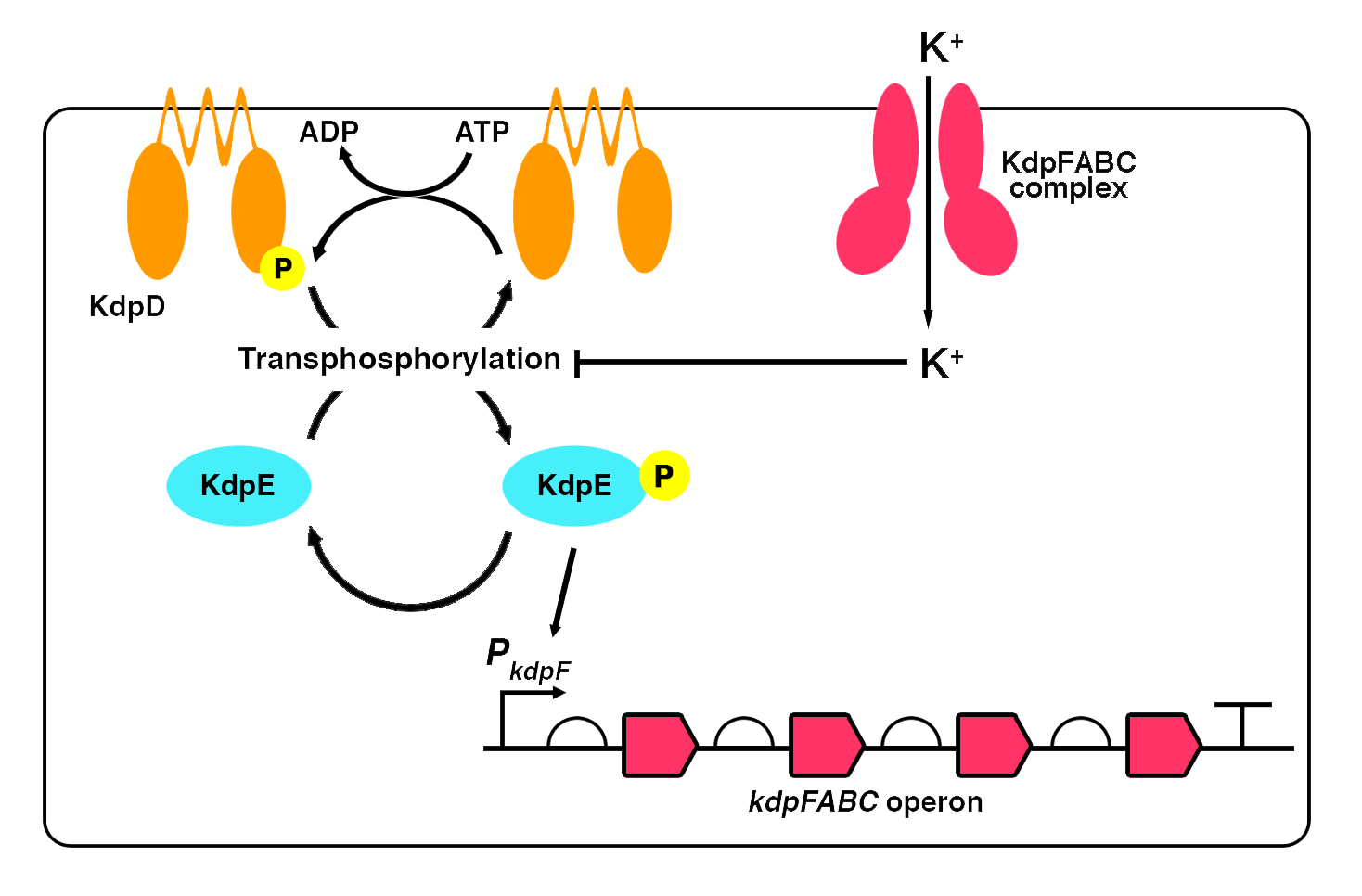Difference between revisions of "Part:BBa K1682000"
Mfcheungaa (Talk | contribs) |
Mfcheungaa (Talk | contribs) |
||
| Line 7: | Line 7: | ||
<br> | <br> | ||
The kdpFABC operon is controlled by the KdpDE two-component system (TCS) which consists of KdpD, a membrane-bound sensor kinase, and KdpE, a cytoplasmic response regulator (Polarek, 1992; Walderhaug, 1992). KdpD is stimulated by both intracellular and extracellular K+ (Jung, 2000; Jung, 2001; Roe, 2000; Yan, 2011a; Laermann, 2013). KdpD phosphorylates KdpE upon low potassium concentration (Voelkner, 1993; Puppe, 1996; Jung, 1997a; Jung, 2000). Under an increase in [K+], KdpD phosphatase activity will be enhanced, causing a decrease in phospho-KdpE and kdpFABC expression. Phosphorylated KdpE turns on the expression of kdpFABC (Zhang, 2014a; Laermann, 2013). | The kdpFABC operon is controlled by the KdpDE two-component system (TCS) which consists of KdpD, a membrane-bound sensor kinase, and KdpE, a cytoplasmic response regulator (Polarek, 1992; Walderhaug, 1992). KdpD is stimulated by both intracellular and extracellular K+ (Jung, 2000; Jung, 2001; Roe, 2000; Yan, 2011a; Laermann, 2013). KdpD phosphorylates KdpE upon low potassium concentration (Voelkner, 1993; Puppe, 1996; Jung, 1997a; Jung, 2000). Under an increase in [K+], KdpD phosphatase activity will be enhanced, causing a decrease in phospho-KdpE and kdpFABC expression. Phosphorylated KdpE turns on the expression of kdpFABC (Zhang, 2014a; Laermann, 2013). | ||
| − | + | ||
| + | ==Construct for characterization == | ||
| + | |||
| + | [[Image:HKUST-Rice 2015 kfig3.PNG|300px|center]] | ||
| + | To make a potassium-sensing device, we obtained the promoter, PkdpF, and combined it with a GFP reporter, BBa_E0240, in BioBrick RFC10 standard so that the promoter activity in different potassium level can be detected and characterized. | ||
| + | |||
| + | |||
<span class='h3bb'>Sequence and Features</span> | <span class='h3bb'>Sequence and Features</span> | ||
<partinfo>BBa_K1682000 SequenceAndFeatures</partinfo> | <partinfo>BBa_K1682000 SequenceAndFeatures</partinfo> | ||
Revision as of 18:19, 13 September 2015
Wild Type PkdpF - potassium responsive promoter
Biology of PkdpF
The potassium ion uptake in E. coli is regulated by several systems under different conditions. The potassium ion transporters, Trk and Kup are constitutively expressed (Epstein & Kim, 1971) while KdpFABC, another transporter is activated under low [K+] conditions (Laimins et al., 1981).
The kdpFABC operon is controlled by the KdpDE two-component system (TCS) which consists of KdpD, a membrane-bound sensor kinase, and KdpE, a cytoplasmic response regulator (Polarek, 1992; Walderhaug, 1992). KdpD is stimulated by both intracellular and extracellular K+ (Jung, 2000; Jung, 2001; Roe, 2000; Yan, 2011a; Laermann, 2013). KdpD phosphorylates KdpE upon low potassium concentration (Voelkner, 1993; Puppe, 1996; Jung, 1997a; Jung, 2000). Under an increase in [K+], KdpD phosphatase activity will be enhanced, causing a decrease in phospho-KdpE and kdpFABC expression. Phosphorylated KdpE turns on the expression of kdpFABC (Zhang, 2014a; Laermann, 2013).
Construct for characterization
To make a potassium-sensing device, we obtained the promoter, PkdpF, and combined it with a GFP reporter, BBa_E0240, in BioBrick RFC10 standard so that the promoter activity in different potassium level can be detected and characterized.
Sequence and Features
- 10INCOMPATIBLE WITH RFC[10]Illegal EcoRI site found at 61
- 12INCOMPATIBLE WITH RFC[12]Illegal EcoRI site found at 61
- 21INCOMPATIBLE WITH RFC[21]Illegal EcoRI site found at 61
- 23INCOMPATIBLE WITH RFC[23]Illegal EcoRI site found at 61
- 25INCOMPATIBLE WITH RFC[25]Illegal EcoRI site found at 61
- 1000COMPATIBLE WITH RFC[1000]


